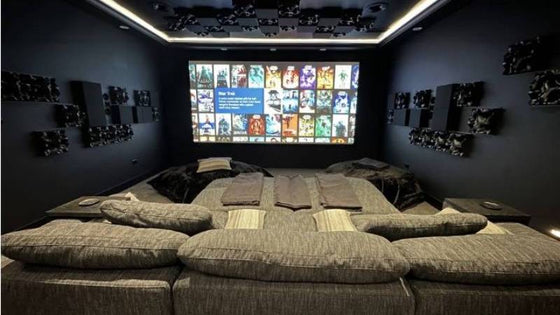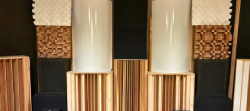Creating a system you love shouldn't be difficult. The Acoustic Frontiers blog is here to help.
This article provides insight into the positioning the center speaker relative to a display such as a TV or projection screen.
1) The center speaker must be timbrally identical to the left and right speakers to prevent audible speaker/speaker timbral and soundstage shifts. It's important to realize that the center speaker is the most important speaker in home theater since the vast majority of the dialog and much of the soundtrack comes from the center channel.

Dedicated centers usually have a left-to-right woofer-tweeter-woofer driver array that's prone to horizontal lobing. Lobing is the result of closely spaced drivers' propensity to sum and cancel each other, which causes uneven response from seat to seat around the room. Better center speakers mitigate the problem with a vertically stacked midrange and tweeter or different crossover points for the individual woofers.
Mark Fleischman, Home Theater Magazine, 2010

2) The acoustical center of all three screen speakers (left, center and right) must be more or less at the same height to prevent audible speaker/speaker timbral and soundstage shifts.
Psychoacoustic studies reveal that we can discern a 5 degree shift in the elevation of a sound source originating in front of us. This occurs because the shape of our outer ear (or Pinna) causes spectral shifts in incoming sounds from different vertical elevations - see this page for more. For this reason the acoustical centers of the left, center and right speaker may vary by a maximum of 5 degrees elevation from the seating area. For 10ft seating distance this is 11" difference and for 13ft this is 14" difference which is certainly not enough to put the center below or above even a moderately sized screen with the left and rights either side of it.
The visual information in movie content influences where we think sounds come from, like the moving mouth of a ventriloquist’s dummy influencing where we perceive the voice to be coming from. This effect helps bring sound and video together even if there is spatial separation between the two and potentially allows for positioning of speakers either above or below a large display. Recent research suggests that for sounds originating straight ahead, as from a center speaker, our vertical discrimination is much like our lateral discrimination - i.e. we can start to differentiate sound / video separation at around 4 degrees.

I think our senses are most attuned to the difference between the relative position of actor's heads relative to their voice and less so for other on screen sounds. If this is true then consider where actor's heads are within the screen when they are speaking - most often within the middle 2/3rds of the screen and very seldom at the screen top or bottom.
So let's restate this rule as a maximum of 4 degrees difference between 1/3rd or 2/3rds of the screen and the center channel acoustical center.
Relevant to this discussion is the home theater design performance requirement that display viewing angles should be between 36 and 50 degrees (see our home theater viewing angle blog for more).
The biggest plasma display is a 65" which means a 92" (~7.5ft) maximum viewing distance. A larger LCD TV with a 85" display would provide 120" (~10') maximum viewing distance. Above a 10' distance we are into the realm of front projection screens.
If we allow the rules described above to apply from screen edge rather than screen center, then this would allow small left, center and right speakers to be placed above or below a 65" or 85" sized display. The acoustical center of such a speaker would need to be not more than 11" from the display edge. Note that the center speaker cannot be placed above or below the TV and the left / rights to the side since this would break performance requirement number 2 above (LCR acoustical centers within 5 degrees of each other).
For larger displays we are really into projection screens
Large displays are, for all but the smallest rooms, projection screens since these are the only display type that can provide the immersive viewing angles of 36-50 degrees found in commercial cinemas.
Acoustic Frontiers is a performance led company so naturally we approach this topic from an audio quality perspective. As you read this article you will understand why our perspective is that the only real option for highest audio performance is to put the center channel speaker behind an acoustically transparent (AT) screen.
Given the above psychoacoustic research there is really ONLY one place for the center speaker for best audio / video tracking, and that is behind the display, within 4 or 5 degrees vertically of the display center.
The ideal setup is to use a center channel loudspeaker that is identical to the left and right loudspeakers and positioned behind the screen.
Widescreen Review, June/July 2013
W
This media room was intentionally designed to feel like part of the home—not a separate, tech-heavy space. Through careful acoustic planning, equipment integration, and final calibration, we achieved a room that is both beautiful to live in and immersive to experience.
"No other subwoofer system I’ve owned even comes close to what this room delivers. Reaching out to Acoustic Frontiers was one of the best decisions I’ve made—I highly recommend working with them if you want to get the most out of your theater."

Nyal Mellor, Founder, Acoustic Frontiers



Nyal Mellor
Author